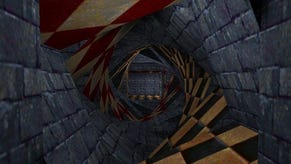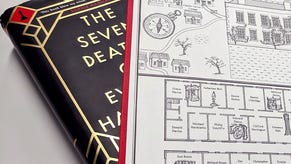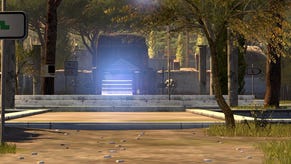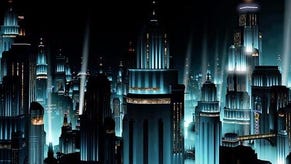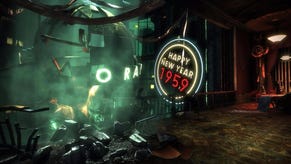BioShock 2
Going deeper.
Meanwhile, your weapons are hardly regular - they're Big Daddy specials. The drill, first of all, is wonderfully savage. Coupled with a lunge move, it grinds splicers to pieces with staggering brutality and fountains of gore, so much so that it's hard to look beyond it for a couple of minutes - until you realise it leaves you exposed over distance, so it's better to do some ranged attacks first. With the rivet gun, for example, which is a kind of nailgun for people who can bench-press whales. Or the spear gun, which pins people to walls from across the room. Or a massive minigun.
As with BioShock 1, there are alternative ammo types for each gun, and these deliberately mess with each weapon's functionality. Explosive spears, for example, burrow through splicer flesh and see the poor dears running around in terror before they disintegrate, along with any of their nearby friends. Trap bolts can be laid on the ground and fire upwards rather ferociously when crossed. Power to the People machines, which provide weapon upgrades, now also come with a third upgrade level, which is designed to modify the utility of a weapon further. The drill, for example, can deflect bullets once fully spruced.
Some of the best bits in the first BioShock were encounters you had a bit of time to plan, laying out traps and taking advantage of water features and other useful bits of the scenery, and the sequel's developers are evidently wise to this, because there are many more opportunities to do so in BioShock 2.
As a Big Daddy, you can adopt Little Sisters, and thanks to a cloudy on-screen pheromone trail they can lead you to bodies ripe to be harvested for ADAM (it's nothing like the escort mission at the end of the first game, incidentally). In Ryan Amusements, the ideal candidate for ADAM extraction happens to be next to a big door and in-between two staircases. Once you instruct the Little Sister to start harvesting ADAM, a harvest meter appears, and splicers lay siege to the area until it's full, so you have to plan your defences and keep your wits (and rivets and spears and drill-bits) about you.
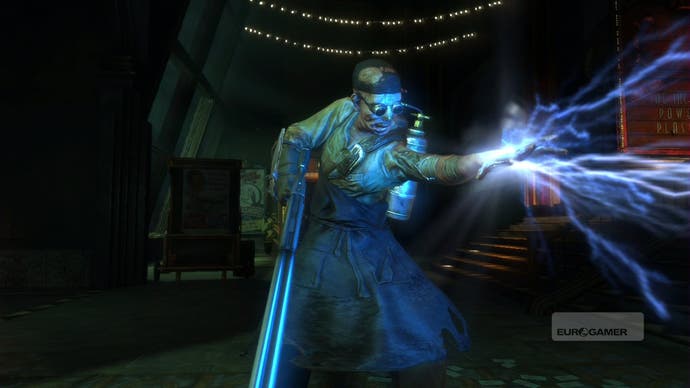
You don't meet Little Sisters by accident, of course, and they are not alone when you do. BioShock 2 welcomes back a couple of Big Daddy archetypes as their guardians, but there's a new one as well: the Rumbler. He's all about controlling his territory, laying down miniature turrets and firing a rocket launcher at you from distance (after which you can pillage these weapons from his corpse, naturally).
Once he's out of the way, you get the usual choice to harvest the Little Sister or adopt her. Adoption is the wrong term though, because it's far from permanent. As well as the responsibility you assume during her forays into ADAM-collection, you eventually reach a point with each Little Sister where you have to decide whether to let her escape through a familiar grandfather-clock shaped vent or to harvest her anyway. If you ask me, harvesting her, having saved her the first time, is more wicked than ever. Hopefully there's a really nasty end sequence for you.
Whichever option you choose, though, you will enrage Sophia Lamb, and she will send the Big Sister after you. By this stage in the Ryan Amusements demo, you've acquired Incinerate and are on the verge of heading back to the train car and finishing the level, and the Big Sister confrontation is not staged around a particular location, so where and when you face her is as much down to you as the game. When you do, it is, as promised, the biggest rumble you've had in the whole of Rapture. And despite the developer's insinuations earlier in the year, there's more than one Big Sister to worry about before the end of the game.
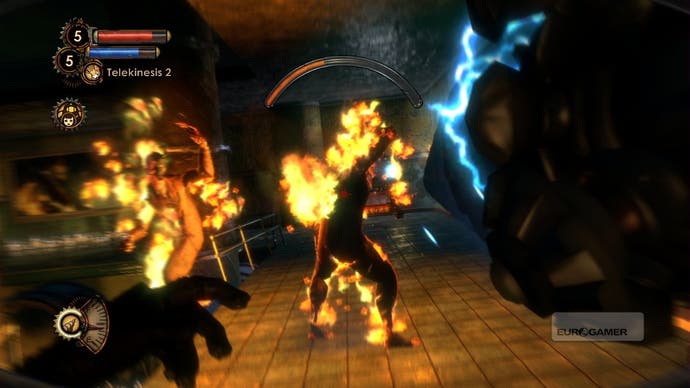
Despite all this action, you still get plenty of time to take in Ryan Amusements. As with the first game, there are secret stashes of weapons, ammo and money tucked in around the margins of every room, along with audio recordings that shed light on the park's role in the events of New Year's Eve 1959. All the while you work, you're contacted by members of the sequel's cast, too, including Lamb's current adversary, and the closest thing the game seems to have to a Frank Fontaine - Augustus Sinclair.
Judging by audio recordings and the fiction that underpins the multiplayer, Sinclair is an opportunist who not only rolled deep in the field of plasmid research but did a lot of Andrew Ryan's dirty work. The logs hint at his role in suppressing Lamb during the period prior to the first game, so it's no surprise to discover, at the end of the demo, that he is the kind of man to - in the words of the game's creative director Jordan Thomas - "play absolutely any side against the middle".
But the star of the demo is the Ryan Amusements exhibits themselves. We get a selective history of how Rapture was actually built, and we get a lot of Ryan's beliefs brought to life by thunder-cracks and automatons. As you walk past a farmhouse scene, with a happy family tending the soil, a spotlight falls and Ryan's voice growls over the top. On the surface, he says, farmers sow and harvest their crops, but do they get to keep the proceeds? A giant hand reaches from the sky and pulls the very roof from over the family's heads. "Noooo," booms the voice from the original game's peerless introduction. Wonderful.



